The Fukui Railway
Amazing old trams in Hokuriku
By Oliver Mayer
While travelling
through Japan in autumn 1994, I decided to stop in
Fukui for a few hours. At that time I was mainly trying to get a few
photos from every tram system in Japan, and while I had been to
Kanazawa, Takaoka and Toyama in 1990 for sightseeing, I had never
bothered to go to Fukui. Fukui is the capital of Fukui prefecture, but
it lacks any major sightseeing attraction (as I saw it at that time),
so I had never been there.
But then, strongly
influenced by the famous first JRS tour in
October 1994, I decided to concentrate on visiting and photographing
Japanese tramways. After that JRS tour had finished, I stayed with
friends in Yokohama, and then had to go to Hokkaido for a conference.
Using a one-week Railpass, I went to Hokkaido, attended the conference,
and then decided to go back to Yokohama along the Sea of Japan via the
Ou, Uetsu, Shinetsu and Hokuriku Lines (Aomori - Akita - Niigata -
Toyama - Fukui - Maibara), from where it was back by Shinkansen. This
route along the Sea of Japan is very scenic, but time consuming. Aomori
to Maibara takes about 13 hours, and you have to change trains at least
three times. Also on some sections, trains run only as often as four
times a day.
That all could of
course not prevent me from going along there, and
my main aims were the tram systems in Toyama, Takaoka and Fukui.
However, as my Railpass was running out, I did not have as much time
for that area as I wanted. After seeing Toyama and Takaoka (and staying
there overnight), I arrived at Fukui around noon on the 1st November
1994 (date noted on my slides). As that was the last day of my
Railpass, I just had about two hours there, and I had to return to
Yokohama on the same day.
Leaving Fukui
station, I soon found the tramway stop. It is in a
rather narrow street, and was in shadow then, so no good opportunities
for photos. I walked along the track and came to the junction at
Shiyakusho-mae (City Hall), and then spent some time between
Honmachi-dori and Koen-guchi stations for the photos on this page. The
road is quite wide there, and it was a good point to shoot some photos,
as there were not too many cars and the trams were going slowly.
I had already been
to many Japanese tram systems and I knew that
many of them were like "living museums", partly using pre-war rolling
stock. So seeing the trams in Fukui was not really a big surprise for
me, although the trams there are special as most of them are
articulated. And they look much older than they actually are! Some data
about the cars on this page:
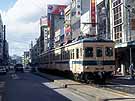
car 81: built by Nippon Sharyo in 1960 for the Nankai Railway,
came later to Fukui. Rebuilt and equipped with airconditioning in 1992.
Still running. But looks much older!
|
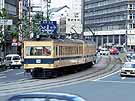
car 143: consisting of former Nagano Railway moha 42 (built in
1929 by Kato) and former Meitetsu mo 907 (built in 1931 by Nippon
Sharyo). Withdrawn in the late 1990s.
|
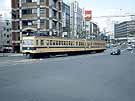
Another shot of car 143
|
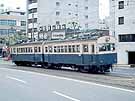
car 161: built in 1933 by Nippon Sharyo for the Fukui Railway.
Smaller than the other trains, as it can only load 150 passengers (200
for all other trains). Looks as old as it is! Withdrawn in the late
1990s.
|
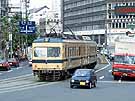
car 202: built in 1960 by Nippon Sharyo for the Fukui Railway
|
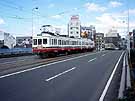
car 302: built in 1967 by the Shizuoka Railway, and came later
from there to Fukui.
|
When I took these
photos, only articulated (or coupled) trains were
used. In the late 1990s, some cars came in from the Nagoya Subway, and
today there are a few services with these cars, especially off-peak and
on weekends. Today, the fleet of the Fukui Tetsudo consists of 14
trains:
- class 80: two trains (two cars each), 1960, former Nankai
- class 120: one train (two cars), 1929/1950, former Meitetsu
- class 140: one train (two cars), 1931/1941, former Nagano Railway
and Meitetsu
- class 200: three trains (two cars each), 1960
- class 300: three trains (two cars each), 1966, former Shizuoka
Railway
- class 600: two cars, 1971/1974, former Nagoya Subway
- class 610: one train (two cars), 1974, former Nagoya Subway
- class 560: one car, 1957, former Hokuriku Railway, then Meitetsu
(Gifu), not in use
There are also
three locomotives:
- deki 1, built in 1951 by Toyo Denki, formerly at Toyo Spinning,
Meitetsu and Enshu Railways
- deki 10, built in 1923, for use with snowploughs
- D-100, diesel loco for snowploughs
The Fukui
Railway is 21 km long, of which 3 km are classified as
tramway and 18 km as railway. While the tram section is all
double-track on street, the single-track on reservation (with a small
part near the tram section with double track). The Fukui Railway has
two northern termini, at Tawaramachi (connection to the Keifuku) and at
Fukui (JR). The southern terminal is called Takefu-shin and is close to
Takefu station (JR). The name Takefu-shin is a bit strange, as normally
the "shin" (which means new) is written first (like Shin-Osaka,
Shin-Nagoya or Shin-Yokohama), but the Fukui Railway uses it the other
way round. I think it is the only railway in Japan to do it like that.
To travel along the
whole line, it takes about 45 minutes and costs
390 Yen. There are three or four trains per hour. Express trains run in
the morning and evening peak.
The Fukui Railway
(then with a different name) was opened between
1924 and 1933, and the section to Kawaramachi in 1950. Two branch lines
from Takefu existed, but were closed in the 1960s and 70s.
Information was taken from:
Japan Tramway Society: Tramways of Japan 2001
LRTA: Electric Railways of Japan, vol. 3
[Home Page]





